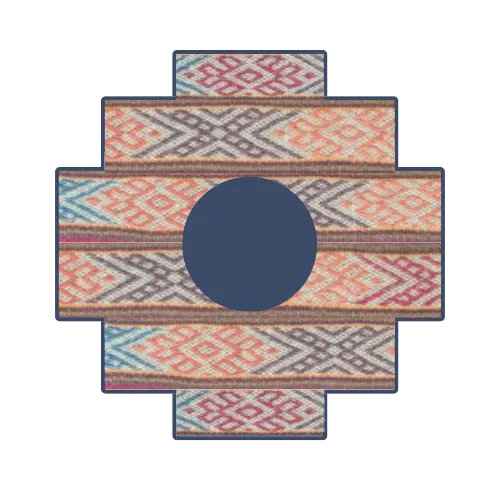Islas Ballestas & Paracas
Itinerary + Travel Tips
We are starting our Discover Peru series with a destination where the desert meets the ocean, and where vineyards produce both wine and the iconic pisco. So definitely you must have some Pisco Sours in Ica and Paracas.
Located along Peru’s southern coast, these neighboring regions offer stunning contrast of desert landscapes, coastal wildlife, and rich history. It is a region of breathtaking contrasts, where vast golden deserts meet the deep blue Pacific Ocean, and the Paracas National Reserve is swarmed with a rich array of protected wildlife. Steeped in history, it was once home to the ancient Paracas culture, which thrived as far back as 800 BCE. Today, Ica is also renowned for producing Peru’s iconic spirit, Pisco. This unique blend of natural beauty, historical depth, and cultural heritage makes Paracas-Ica a truly captivating destination.
Originally from Cusco, I am used to being surrounded by the jungle, the mountains and the omnipresent Inca culture. But I had often heard about the beauty of the Peruvian coastal regions from family and friends.
I decided to embark on an a 3-day adventure to Paracas and Ica, an increasingly touristic destination which shines light on another side of Peru, one that I am not familiar with.
Paracas Town
We departed from Lima by car and drove down for 3 hours to reach Paracas Town, a small fisherman town just north of the Paracas National Reserve. Recommend not getting into town too late, so that you have time to book your boat trip to the Islas Ballestas and guided trip to the National reserve for the next day. During the non-peak season one day in advance for booking is enough. We went after Easter and didn’t have any issues. However, for the summer months (Jan-Mar) recommend booking in advance.
We opted to rent an Airbnb since we were a group of five, which made it more convenient for us. However, there are plenty of hotels and hostels to suit every preference. Your choice will depend on your budget and the amenities you’re looking for—whether it’s a pool, private beach access, or other extras.
Paracas Town is quite small and the main attraction is the sea-front avenue which hosts a variety of bars and restaurants. Naturally, ceviche is on every menu, and I recommend taking advantage of the fresh seafood that comes with a fisherman town. We had dinner at La Muña, Bamboo Lodge’s restaurant, where I indulged in perfectly grilled octopus—it was outstanding. The other dishes were equally delightful, including the “Fettuccini de langostinos en salsa huancaína” and, of course, the classic ceviche. While there are a few charming rooftop bars in town, the nightlife outside of the summer season is fairly quiet. That said, you’ll find Happy Hour in nearly every bar, featuring the iconic Pisco Sour, making it well worth a visit.
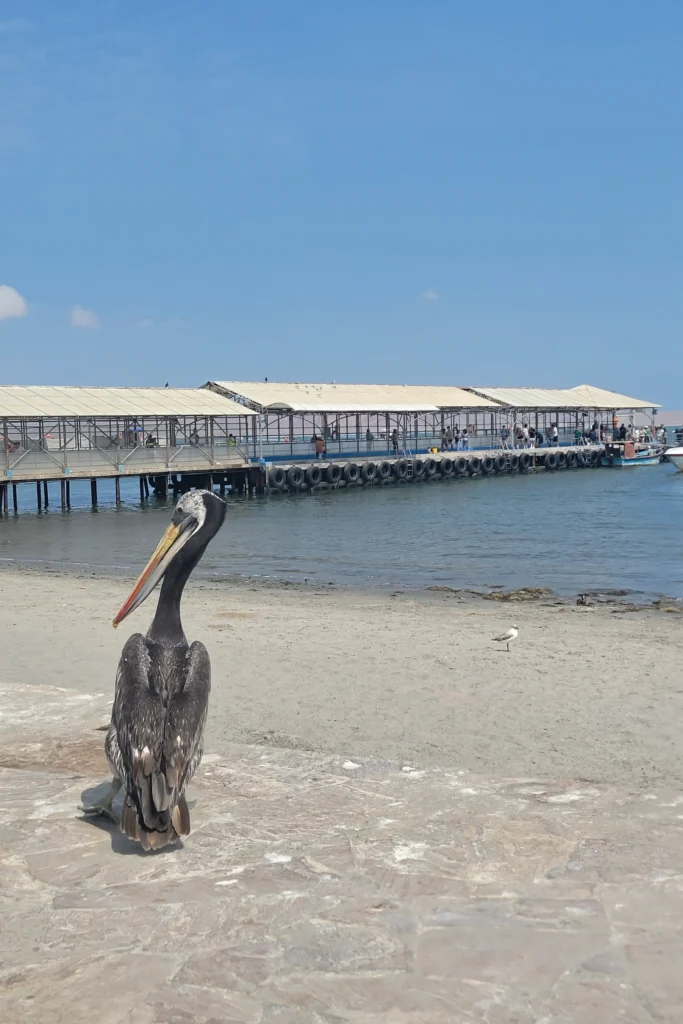
Islas Ballestas
The next day, we got up early for the boat trip and lined up on the docks. We hopped on the boat with roughly 30 other fellow passengers and we left pretty swiftly. On board, there is a guide that alternates between Spanish and English. If you prefer, private tours are available, but we were very satisfied with the group tour we chose. It was well-organized, and the guides provided excellent information throughout. In both group and private tours, no one disembarks from the boat, as the entire tour is conducted on the water to protect the area’s delicate ecosystem. Just be sure to arrive at the port 10–15 minutes early to ensure a smooth start.
The first attraction on the boat ride is El Candelabro. This is a large and intriguing drawing of what appears to be a chandelier, outlined on a dune on the coast. These lines, made in the same style as the Nazca lines, are very impressive in size – the length of the Candelabra is near 200 meters!
The guide explains the many competing theories about the origin and intended purpose of these lines. Despite its mysteries, it is truly remarkable that these lines have stayed intact over the years since approx. 200 BCE – 200 CE, the time of the Paracas culture.
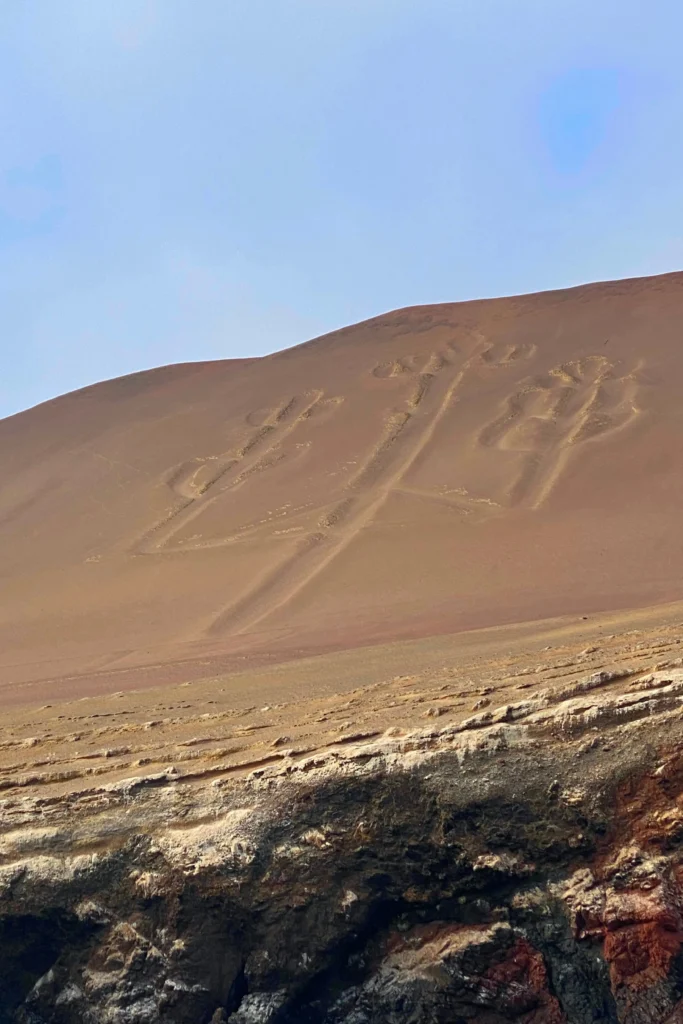
The first attraction on the boat ride is El Candelabro. This is a large and intriguing drawing of what appears to be a chandelier, outlined on a dune on the coast. These lines, made in the same style as the Nazca lines, are very impressive in size – the length of the Candelabra is near 200 meters!
The guide explains the many competing theories about the origin and intended purpose of these lines. Despite its mysteries, it is truly remarkable that these lines have stayed intact over the years since approx. 200 BCE – 200 CE, the time of the Paracas culture.

The next stop is the islands. These islands are home to a variety of birds as well as penguins and sea lions. I saw plenty of sea lions and was lucky to see a few penguins waddling on the rocks but if you want to see plenty of penguins the right time is December to February.
Fun poop fact: In the 19th century, Peru exported 10 million tons (£100mln worth) of guano (bird poop), largely collected from islands such as the Islas Ballestas, to the Western world – it was the best fertilizer at the time! You can still see remains of the machinery and structures that were built back then to extract this valuable resource. If you would like to learn more, i advise to read this article from National Geographic.
The entire tour lasted about 2 hours, though most of that time was spent the ride from Paracas Town to the islands. That said, you really don’t need more time. The guides are excellent at ensuring everyone gets a chance to see the wildlife they point out. Tours are available only at 8 a.m. and 10 a.m., and we recommend taking the early one as the ocean is calmer, it can get quite bumpy later in the day. Also, taking the early tour lets you embark on the Paracas National Reserve tour.
Paracas National Reserve
After a busy morning in the Islas Ballestas, we were then headed to the heart of the Paracas National Reserve. We booked this guided tour with a separate company which provides you with a guide that drives you around the park.
There is an option for you to hire a buggy to discover the park rather than with a company van. However, I do not recommend doing buggy here – we passed a few buggies in the park and the drivers were mainly driving in a straight line and did not seem overjoyed! There is also the option to rent bikes but during summer time it can get quite hot, so be careful
The National Reserve is a truly unique mix – a large desert next to the ocean. This results in absolutely stunning landscapes and beaches such as the red colored sand beach below.
The driver will take you around the park and stop at various locations which are a mix of beaches and panoramic views of the park. Something I only discovered once on the tour is that there is a beach which allows swimming, La Mina. Next time, I will make sure to let the guide know upfront that I would like to spend a bit more time on the beach where swimming is permitted. And I won’t forget my bathing suit!
The guide explains the many competing theories about the origin and intended purpose of these lines. Despite its mysteries, it is truly remarkable that these lines have stayed intact over the years since approx. 200 BCE – 200 CE, the time of the Paracas culture.
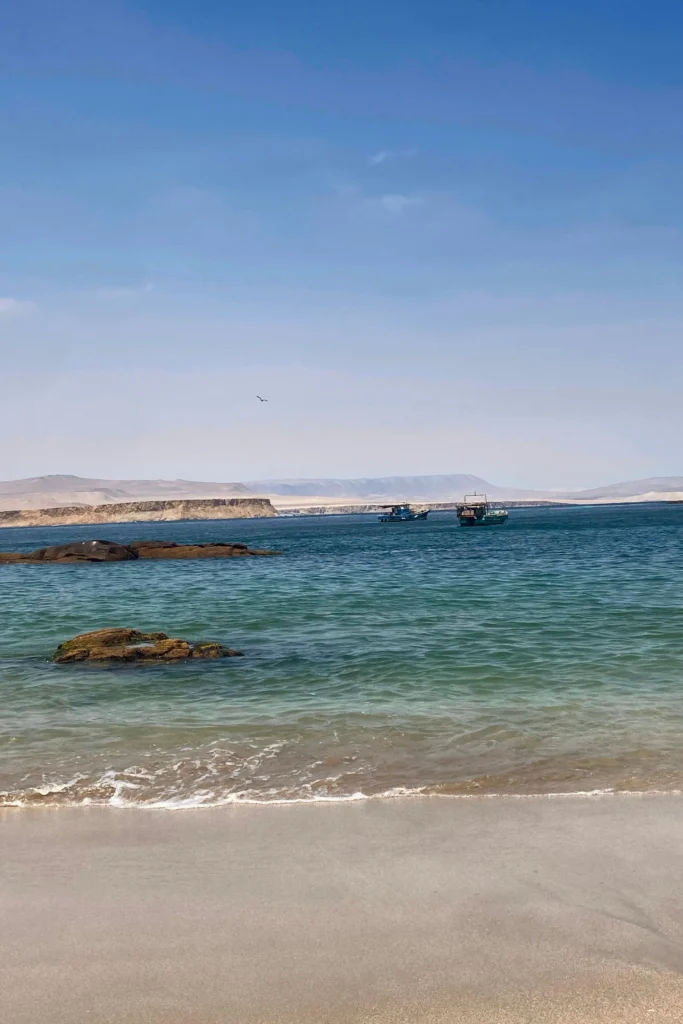
The driver will take you around the park and stop at various locations which are a mix of beaches and panoramic views of the park. Something I only discovered once on the tour is that there is a beach which allows swimming, La Mina. Next time, I will make sure to let the guide know upfront that I would like to spend a bit more time on the beach where swimming is permitted. And I won’t forget my bathing suit!
The guide explains the many competing theories about the origin and intended purpose of these lines. Despite its mysteries, it is truly remarkable that these lines have stayed intact over the years since approx. 200 BCE – 200 CE, the time of the Paracas culture.

The entrance fee (around 20 soles for internationals) also includes access to 2 museums, one about the history of the Paracas Culture and another about the wildlife in the area. These can be visited on the way back from the Reserve to Paracas town. Although we were quite tired from the day, we decided to give the museums a try. And I am very glad that we did because both were excellent. I particularly recommend giving a go at the Paracas Culture museum which details the history of one of the earliest cultures in Peru which has shaped many customs that still exist today.
Another fun fact: this culture practiced cranial deformation and trepanation. It’s fascinating to see how, from such early times, they engaged in surgical procedures to treat various ailments.
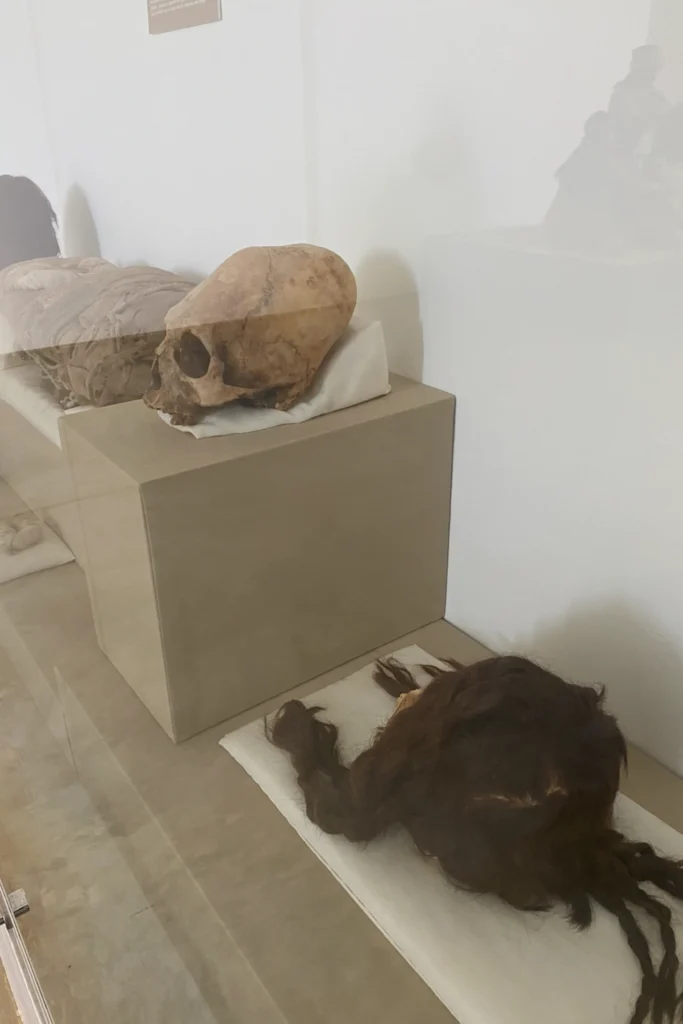
The entrance fee (around 20 soles for internationals) also includes access to 2 museums, one about the history of the Paracas Culture and another about the wildlife in the area. These can be visited on the way back from the Reserve to Paracas town. Although we were quite tired from the day, we decided to give the museums a try. And I am very glad that we did because both were excellent. I particularly recommend giving a go at the Paracas Culture museum which details the history of one of the earliest cultures in Peru which has shaped many customs that still exist today.
Another fun fact: this culture practiced cranial deformation and trepanation. It’s fascinating to see how, from such early times, they engaged in surgical procedures to treat various ailments.

After a busy day, we were eager to unwind on the pier with some Pisco Sours. If you prefer beer, Karamba Resto Bar offers an excellent selection of draft and craft brews. We arrived early to secure a spot on their balcony, allowing us to fully enjoy our drinks while watching a stunning sunset as the sun dipped below the horizon and into the ocean.
The next morning, before heading out, we decided to go for a run and explore a bit more. To our delight, we arrived at the border between the town and Paracas National Reserve, where we spotted a large flock of flamingos at the end of Av. Los Libertadores. Although we couldn’t get too close due to the area’s protected status, witnessing hundreds of flamingos together was truly breathtaking. If you plan to visit this spot to see these magnificent birds, try to go early in the morning (around 7 a.m.), as they tend to leave later in the day.
Another fun fact: the flag of Peru was inspired by flamingos, a story believed by some Peruvians. Legend has it that José de San Martín was inspired by the vibrant colors of the flamingos he encountered, which influenced the design of the flag. The striking red symbolizes the blood shed for independence, while the white represents peace and purity, reflecting the country’s rich biodiversity.
This ended our stay at Paracas Town, leaving us with a great taste of what is yet to come while discovering Ica region, our next blog.
Day 1 (half day) – Arrival in Paracas
Evening
- Arrive to Paracas from Lima (3 hours drive or bus via Cruz del Sur/Peru Hop)
- Book tours for Islas Ballestas and Paracas National Reserve (can book online as well)
- Check in, enjoy dinner, and unwind
Day 2 (full day) – Tours day
Morning
- Depart for Islas Ballestas boat tour at 8am from the docks
Afternoon
- Lunch and relax before the next tour
Evening
- Guided tour of Paraca National Reserve
- end the tour at the beach La Mina (swimming allowed)
- Option to travel to Ica or stay overnight in Paracas
Key Considerations
When is the best time to visit Paracas?
- For sunny, warm beach weather, visit during summer (December to March).
- For wildlife spotting (especially penguins), visit April to November.
- Penguins: Best seen July to October; begin arriving in April.
- Flamingos: Peak season is July to October.
- Sea lions: Seen year-round.
Note: April–November has cooler weather and fewer crowds.
How many days do you need in Paracas?
- One full day is enough to visit both Islas Ballestas and the Paracas National Reserve.
What is Paracas known for?
- Paracas is famous for the Islas Ballestas, the Paracas National Reserve, and its rich marine and desert ecosystems.
What are the top things to do in Paracas?
- Islas Ballestas boat tour – Take the 8 a.m. tour for calmer seas and better wildlife viewing.
- Paracas National Reserve – Explore by van, bike, or ATV (avoid midday heat if biking).
- Visit the museums inside the reserve to learn about the ancient Paracas culture.
- Enjoy fresh seafood and sip Pisco Sours by the waterfront
